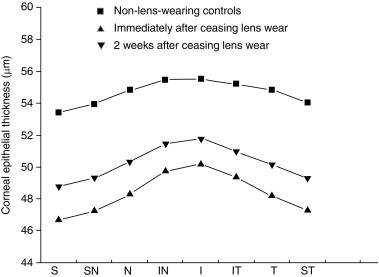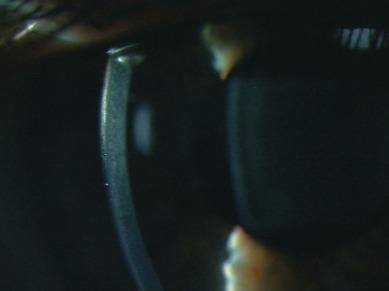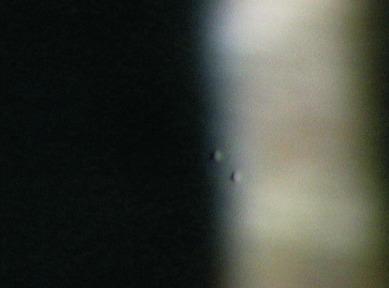Physical Address
304 North Cardinal St.
Dorchester Center, MA 02124
A small number of vacuoles and/or bullae (singular: ‘bulla’) can sometimes be observed in the corneas of contact lens wearers. Although they appear to be clinically innocuous, vacuoles and bullae can be confused with other small epithelial inclusions that have potentially more serious clinical ramifications, and it is for this reason that their clinical presentation is given due consideration in this book.
One of the earliest recorded visual disturbances of contact lens wear was the appearance of haloes. Research conducted periodically throughout the past 60 years has concluded that the source of these haloes is a pathological disturbance to the corneal epithelium, in the form of oedema. Epithelial vacuoles and/or bullae may represent exaggerated clinical manifestations of the tissue abnormalities that cause epithelial oedema.
Ersan et al. evaluated corneal epithelial thicknesses of 30 soft lens wearers, 30 refraction-matched controls and 30 patients with emmetropia by using anterior segment optical coherence tomography. The mean corneal epithelial thicknesses in the soft contact lens–wearing, spectacle-wearing and emmetropic groups were 48.97 ± 5.45, 52.18 ± 4.84 and 53.18 ± 5.05 μm, respectively. The corneal epithelium of soft lens wearers was significantly thinner than in both the spectacles and emmetropic groups (p = 0.044 and 0.006, respectively).
Lei et al. measured epithelial thickness in 56 subjects immediately after cessation of contact lens wear and 2 weeks later, as well as in 94 non-lens-wearing control subjects, by using the RTVue-100 Fourier-domain anterior segment optical coherence tomography system. Immediately after cessation of lens wear, the corneal epithelium was significantly thinner than that of control subjects. After 2 weeks, the corneal epithelium had increased in thickness but was still less than that of the controls. This finding suggests that normal, uncomplicated contact lens wear induces corneal epithelial thinning ( Fig. 20.1 ).

Corneal epithelial thinning is attributed to a number of factors, including physical compression of the epithelium by the contact lens, metabolic disturbances to the epithelium beneath the lens and hyperosmolarity of the tear film, leading to epithelial deturgescence.
Observations of contact lens–induced epithelial thinning suggest that in clinical trials investigating contact lens–induced corneal epithelial oedema, the thickness of the corneal epithelial of uncomplicated soft lens wearers should serve as the experimental control.
Gleason et al. monitored the level of epithelial oedema in patients wearing various lens types over a 12-month period ( Fig. 20.2 ). Epithelial oedema was found to occur at an incidence (expressed as the percentage of eyes per year) of 0.3% for daily wear of super-permeable rigid lenses, 1.1% for extended wear of super-permeable rigid lenses, 1% for daily-wear low-Dk (58% water content) hydrogel lenses and 3.6% for extended-wear low-Dk (58% water content) hydrogel lenses.

In 1992, Stapleton et al. reported that of the 1,104 patients with contact lens–related disorders presenting to an eye clinic, two (0.2%) displayed ‘epithelial thickening’. Of the extensive hospital-based surveys of contact lens complications conducted between 2009 and 2018 – carried out in China, India, Nepal, Singapore, the USA and the UK – only one study reported the observation of epithelial oedema. This was in the survey conducted in Singapore by Teo et al., where 12 cases of epithelial oedema were observed among 953 contact lens wearers (1.3%).
Corneal epithelial oedema can be observed in association with other pathological changes in contact lens wear. For example, Tabatabaei et al. observed corneal epithelial oedema, amongst other pathologies, in a case of atypical sterile ring infiltrates occurring as a result of poor lens care during soft silicone hydrogel contact lens wear. Smear, culture and confocal microscopy confirmed this to be a sterile inflammatory reaction.
It is possible to quantify the level of epithelial oedema by determining the pixel intensity of confocal microscopic images of the basal cell layer of the corneal epithelium. This technique has been used to assess epithelial oedema occurring after cataract surgery and in patients with bullous keratopathy, but this has yet to be validated for the assessment of contact lens-induced epithelial oedema.
According to Hickson and Papas, epithelial vacuoles can be observed in 10% of the normal non-lens-wearing population. Zantos reported that the prevalence of vacuoles in patients wearing low-Dk/t extended-wear hydrogel lenses is about 32%. He also suggested that this value may be higher in patients with aphakia.
When viewed under high magnification with the slit lamp biomicroscope, vacuoles appear to be spherical bodies located within the corneal epithelium, about the same size as epithelial microcysts (5–30 μm in diameter). They are almost perfectly round in shape and have distinct edges. When viewed under indirect illumination against the background of a dark pupil and an illuminated iris, vacuoles display ‘un-reversed illumination’; that is, the distribution of light within the vacuole is the same as that of the background ( Fig. 20.3 ).

Zantos noted that fewer than 10 vacuoles were observed in a given eye of a patient wearing hydrogel lenses on an extended-wear basis. He noted that they may occur concurrently – but apparently unrelated to – microcysts in the same eye.
Vacuoles are usually observed towards the mid-periphery of the cornea. They occur as discrete units in most cases but occasionally are observed in clusters of two or four vacuoles. Apart from this, there is no particular pattern or distribution. Single epithelial vacuoles are sometimes observed in non–lens wearers, but, almost invariably, these are located at the corneal periphery. A curious feature of vacuoles is that they tend to occur in areas directly overlying corneal opacities in patients with aphakia.
Become a Clinical Tree membership for Full access and enjoy Unlimited articles
If you are a member. Log in here